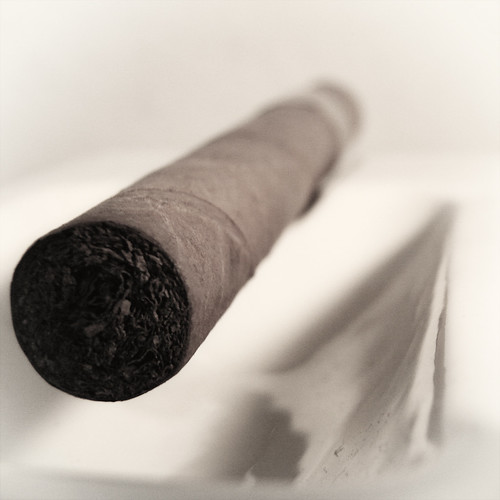
Although Cuba is relatively small, there are two separate
mountain ranges which traverse the island, and enough elevation changes and
topographical anomalies scattered about to create literally hundreds of unique
agricultural growing zones. These regional differences and micro-climatic
characteristics have worked to protect certain growing areas from the
encroachment of sugar plantations, and large scale agricultural production in
general.
The peasant farmers in these areas have become familiar with
the personalities of every twist and turn of the land; every nuance of the
soil. The result is the ability to refine planting and growing strategies
designed to produce quality instead of quantity; something that corporate and
large scale agricultural concerns can
only dream of.
A Friend's Special Treat
In the early 1960s, Eduardo Ribera had been growing tobacco
on several scattered plots near foothills surrounding his village for many
years, and his father before him. He knew why the tobacco leaves near the big
ceiba tree on the hill dried faster than those close to the stream, down the
road a bit. He felt it in his bones, but he could never have explained it to
anyone, even if he'd wanted to.
Every year, just before selling his harvest to Cubatabaco,
the state owned marketing agency, Eduardo would carefully select and prepare
what he knew to be the best mix of his product. He used this material to
prepare for himself, and a few select friends, his own special brand of homemade
cigars. No big deal to him, just the skimming off a little cream from the top
before sending the rest of to be used for whatever the marketer saw fit.
In early 1965, a neighbors' son, now working in far off
Havana, was just returning to the capital after a brief visit home to see his
parents. Eduardo had known him since he was a child, and would give him a box
of his home made cigars on each of his visits. Something to remind him of home
when he returned to the big city.
Simply Esplendido
Back in Havana, one evening his employer stopped and asked
the young man where he was getting those unusually aromatic cigars he always
seemed to have. “They're a gift from a friend, who makes them himself, commandante”,
he replied.
He offered his boss one to try, and as the first few curls
of light blue smoke drifted away, a smile of appreciation and amazement came
across his face. Fidel Castro knew a good cigar when he smoked one, and he
instantly knew that this was the best one of his life. Ever.
A Star Is Born
When Eduardo Ribera saw the jeep pull up in-front of his
small home, he instantly recognized his neighbor's son in the back seat. He
also instantly recognized the passenger in the front. Eduardo was flattered, if
a little shocked, as Fidel told him his days of selling his crop to the state owned
agency were over. From now on, Eduardo's homemade cigars were going to be
produced at a special factory being set-up for just that purpose at a home in El
Laguito, just outside of Havana.
The best hand rollers in Havana were recruited to work at El
Laguito, and soon hundreds of boxes of Eduardo's homemade treats were being
produced each week. Christened with the indigenous Taino Indian name for
tobacco, the first Cohiba Cigars began to appear.
Getting your hands on a box can prove to be a little tricky.
Only a few thousand boxes are produced annually, and buying them in the US is
strictly forbidden. But somewhere in a hidden valley of the Cuban hinterland,
friends of Eduardo Ribera's family are still treated to a special parting gift
as they return home. No big deal really. Just a box of his home made cigars.
Hector Salinas – Quality tobacco has been a passion of mine
for a number of years. It's what drew me to Cuba in the first place. And while
I enjoy an e-cigarette now and again when smoking isn't permitted, Cuban cigars
remain my true love.
Resources:
No comments:
Post a Comment